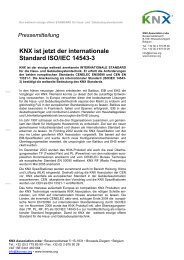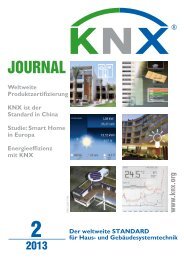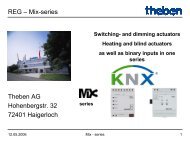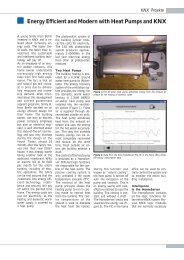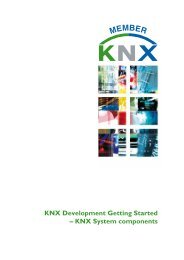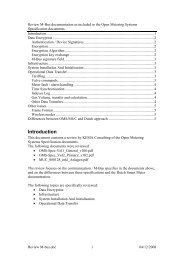KNX Journal 2011-1
KNX Journal 2011-1
KNX Journal 2011-1
Create successful ePaper yourself
Turn your PDF publications into a flip-book with our unique Google optimized e-Paper software.
<strong>KNX</strong> Partners<br />
rithms. This is an essential prerequisite for<br />
the commercial adjustment of the electrical<br />
loads in Smart Grid houses of the future. For<br />
example, the total consumption in a partial<br />
power grid e.g. a low-voltage network can<br />
be adapted to the local energy production<br />
from renewable energy.<br />
Target<br />
For teaching purposes, the test stand<br />
will serve to provide the students with<br />
both theoretical and practical knowledge.<br />
The cooperative partnerships with ABB,<br />
Crestron, EEBus and <strong>KNX</strong> (<strong>KNX</strong> Scientific<br />
Partnership) will help in this regard. These<br />
partnerships are not financially based but<br />
rather are used to exchange knowledge and<br />
should therefore help to achieve realistic<br />
or market-based research and training of<br />
the students in the area of Smart Grid and<br />
security of supply.<br />
In their main studies, the students must<br />
carry out eight experiments on test rigs.<br />
One of the experiments is carried out<br />
next semester on the building technology<br />
test stand. On the one hand, the students<br />
learn what an intelligent building control<br />
system can look like, which is necessary in<br />
the Smart Grid of the future. On the other<br />
hand, they must themselves plan a building<br />
control system in the preliminary stages<br />
using the example of a small flat and then<br />
implement it in practice on the test stand.<br />
The students use corresponding software<br />
tools for creating circuit diagrams (Striebel<br />
& John Strieplan) and for programming the<br />
building control system (ETS).<br />
In addition, the students carry out research<br />
work on the test stand such as bachelor<br />
and master theses. In particular, theses are<br />
assigned in the area of load management.<br />
They examine for example to what extent<br />
the problem of voltage boost in a local<br />
network with a high photovoltaic supply<br />
can be counteracted through load adjustment,<br />
thus preventing an overload of the<br />
local network. In the future, high numbers of<br />
electric vehicles could lead to simultaneous<br />
charging for example in the evening when<br />
many people are driving home from work<br />
and want to charge their vehicles. This<br />
would result in a high load which could<br />
cause problems for the energy grid in the<br />
same way as an excessive feed-in. In their<br />
research work, students examine to what<br />
extent staggered charging can reduce the<br />
problem dependent on the parking time.<br />
They also program special charging modes<br />
based on variable electricity tariffs. Additionally,<br />
corresponding load adjustment<br />
algorithms are developed which should be<br />
evaluated for their suitability using simulations<br />
of real low-voltage networks. These<br />
algorithms are then implemented in the<br />
test stand and road-tested.<br />
<strong>KNX</strong> energy actuators<br />
<strong>KNX</strong> Smart Metering<br />
Test stand under development<br />
<strong>Journal</strong> 1/<strong>2011</strong><br />
47




